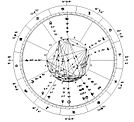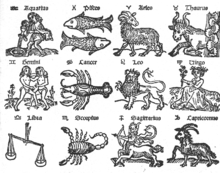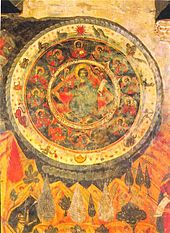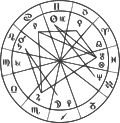- Zodiac
-
See also: Zodiac (disambiguation)
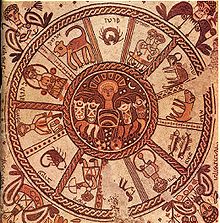 Wheel of the zodiac: This 6th century mosaic pavement in a synagogue incorporates Greek-Byzantine elements, Beit Alpha, Israel.
Wheel of the zodiac: This 6th century mosaic pavement in a synagogue incorporates Greek-Byzantine elements, Beit Alpha, Israel.
In astronomy, the zodiac (Greek: ζῳδιακός, zōdiakos) is a circle of twelve 30° divisions of celestial longitude which are centred upon the ecliptic: the apparent path of the Sun across the celestial sphere over the course of the year. The paths of the Moon and visible planets also remain close to the ecliptic, within the belt of the zodiac which extends 8-9° north or south of the ecliptic, as measured in celestial latitude. Historically, these twelve divisions are called signs. Essentially, the zodiac is a celestial coordinate system, or more specifically an ecliptic coordinate system, which takes the ecliptic as the origin of latitude, and the position of the sun at vernal equinox as the origin of longitude.
Contents
Usage
It is known to have been in use by the Roman era, based on concepts inherited by Hellenistic astronomy from Babylonian astronomy of the Chaldean period (mid-1st millennium BC), which, in turn, derived from an earlier system of lists of stars along the ecliptic.[1] The construction of the zodiac is described in Ptolemy's Almagest (2nd century AD).
The term zodiac derives from Latin zōdiacus, which in its turn comes from the Greek ζῳδιακὸς κύκλος (zōdiakos kuklos), meaning "circle of animals", derived from ζώδιον (zōdion), the diminutive of ζῶον (zōon) "animal". The name is motivated by the fact that half of the signs of the classical Greek zodiac are represented as animals (besides two mythological hybrids).
Although the zodiac remains the basis of the ecliptic coordinate system in use in astronomy besides the equatorial one, the term and the names of the twelve signs are today mostly associated with horoscopic astrology.
The term "zodiac" may also refer to the region of the celestial sphere encompassing the paths of the planets corresponding to the band of about eight arc degrees above and below the ecliptic. The zodiac of a given planet is the band that contains the path of that particular body; e.g., the "zodiac of the Moon" is the band of five degrees above and below the ecliptic. By extension, the "zodiac of the comets" may refer to the band encompassing most short-period comets.[2]
History
Further information: Former constellations and Star Names: Their Lore and MeaningEarly history
Astrology Background History of astrology Astrology & astronomy Sidereal vs. Tropical Traditions Babylonian · Hellenistic Islamic · Western Hindu · Chinese More... Branches Natal astrology Electional astrology Horary astrology Mundane astrology More... Categories Astrologers Organizations Astrological texts Astrological writers Astrology Portal Main article: Babylonian zodiacFurther information: MUL.APINThe division of the ecliptic into the zodiacal signs originates in Babylonian ("Chaldean") astronomy during the first half of the 1st millennium BCE, likely during Median/"Neo-Babylonian" times (7th century BCE),[3] The classical zodiac is a modification of the MUL.APIN catalogue, which was compiled around 1000 BCE. Some of the constellations can be traced even further back, to Bronze Age (Old Babylonian) sources, including Gemini "The Twins", from MAŠ.TAB.BA.GAL.GAL "The Great Twins", and Cancer "The Crab", from AL.LUL "The Crayfish", among others.
Babylonian astronomers at some stage during the early 1st millennium BC divided the ecliptic into twelve equal zones of celestial longitude to create the first known celestial coordinate system: a coordinate system that boasts some advantages over modern systems (such as equatorial coordinate system). The Babylonian calendar as it stood in the 7th century BCE assigned each month to a sign, beginning with the position of the Sun at vernal equinox, which, at the time, was depicted as the Aries constellation ("Age of Aries"), for which reason the first constellation is still called "Aries" even after the vernal equinox has moved away from the Aries constellation due to the slow precession of the Earth's axis of rotation.[4]
Knowledge of the Babylonian zodiac is also reflected in the Hebrew Bible. E. W. Bullinger interpreted the creatures appearing in the books of Ezekiel and Revelation as the middle signs of the four quarters of the Zodiac,[5][6] with the Lion as Leo, the Bull is Taurus, the Man representing Aquarius and the Eagle representing Scorpio. Richard Hinckley Allen, Star Names: Their Lore and Meaning, Vol. 1 (New York: Dover Publications, 1899, p. 213-215.) argued for Scorpio having previously been called Eagle. for Scorpio.</ref> Some authors have linked the twelve tribes of Israel with the twelve signs. Martin and others have argued that the arrangement of the tribes around the Tabernacle (reported in the Book of Numbers) corresponded to the order of the Zodiac, with Judah, Reuben, Ephraim and Dan representing the middle signs of Leo, Aquarius, Taurus and Scorpio, respectively.[7][8] Such connections were taken up by Thomas Mann, who in his novel Joseph and His Brothers, attributes characteristics of a sign of the zodiac to each tribe in his rendition of the Blessing of Jacob.
Hellenistic and Roman era
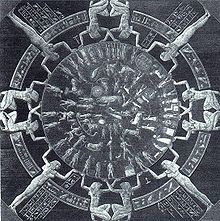 The 1st century BC Dendera zodiac (19th-century engraving)
The 1st century BC Dendera zodiac (19th-century engraving)
The Babylonian star catalogues entered Greek astronomy in the 4th century BC, via Eudoxus of Cnidus and others. Babylonia or Chaldea in the Hellenistic world came to be so identified with astrology that "Chaldean wisdom" became among Greeks and Romans the synonym of divination through the planets and stars. Hellenistic astrology originated from Babylonian and Egyptian astrology. Horoscopic astrology first appeared in Ptolemaic Egypt. The Dendera zodiac, a relief dating to ca. 50 BC, is the first known depiction of the classical zodiac of twelve signs.
Particularly important in the development of Western horoscopic astrology was the astrologer and astronomer Ptolemy, whose work Tetrabiblos laid the basis of the Western astrological tradition. Under the Greeks, and Ptolemy in particular, the planets, Houses, and signs of the zodiac were rationalized and their function set down in a way that has changed little to the present day.[9] Ptolemy lived in the 2nd century AD, three centuries after the discovery of the precession of the equinoxes by Hipparchus around 130 BC, but he ignored the problem, by dropping the concept of a fixed celestial sphere and adopting what is referred to as a tropical coordinate system instead.
Hindu zodiac
The Hindu zodiac uses the sidereal coordinate system which makes reference to the fixed stars. The Tropical zodiac (of Mesopotamian origin), is divided by the intersections of the ecliptic and equator which shift is relation to the backdrop of fixed stars at a rate of 1° every 72 years, creating the phenomenon known as precession of the equinoxes. The Hindu zodiac, being sidereal, does not maintain this seasonal alignment but there are still similarities between the two systems. The Hindu zodiac signs and corresponding Greek signs sound very different, being in Sanskrit and Greek respectively, but their symbols are nearly identical. For example, dhanu means "bow" and corresponds to Sagittarius, the "archer", and kumbha means "water-pitcher" and corresponds to Aquarius, the "water-carrier". The correspondence of signs is taken to suggest the possibility of early interchange of cultural influences.
Middle Ages and Early Modern period
The High Middle Ages saw a revival of Greco-Roman magic, first in Kabbalism and later continued in Renaissance magic. This included magical uses of the zodiac, as found, e.g., in the Sefer Raziel HaMalakh.
The zodiacal symbols are Early Modern simplifications of conventional pictorial representations of the signs, attested since Hellenistic times. The symbols are encoded in Unicode at positions U+2648 to U+2653 n the Miscellaneous Symbols block...
The twelve signs
Main article: Astrological signWhat follows is a list of the twelve signs of the modern zodiac (with the ecliptic longitudes of their first points), where 0° Aries is understood as the vernal equinox, with their Latin, Greek, Sanskrit, and Babylonian names (but note that the Sanskrit and the Babylonian name equivalents denote the constellations only, not the tropical zodiac signs). Also, the "English translation" is not usually used by English speakers. The Latin names are standard English usage.
№ Symbol Long. Latin name English translation Greek name Sanskrit name Sumero-Babylonian name[10] 1 ♈ 0° Aries The Ram Κριός/Kriós Meṣa (मेष) MUL LUḪUN.GA "The Agrarian Worker", Dumuzi 2 ♉ 30° Taurus The Bull Ταῦρος/Tauros Vṛiṣabha (वृषभ) MULGU4.AN.NA "The Steer of Heaven" 3 ♊ 60° Gemini The Twins Δίδυμοι/Didymoe Mithuna (मिथुन) MULMAŠ.TAB.BA.GAL.GAL "The Great Twins" (Castor and Pollux) 4 ♋ 90° Cancer The Crab Καρκῖνος/Karkinos Karkaṭa (कर्कट) MULAL.LUL "The Crayfish" 5 ♌ 120° Leo The Lion Λέων/Léōn Siṃha (सिंह) MULUR.GU.LA "The Lion" 6 ♍ 150° Virgo The Maiden Παρθένος/Parthénos Kanyā (कन्या) MULAB.SIN "The Furrow"; "The Furrow, the goddess Shala's ear of corn" 7 ♎ 180° Libra The Scales Ζυγός/Zygós Tula (तुला) zibanitum "The Scales" 8 ♏ 210° Scorpio The Scorpion Σκoρπιός/Skorpiós Vṛścika (वृश्चिक) MULGIR.TAB "The Scorpion" 9 ♐ 240° Sagittarius The (Centaur) Archer Τοξότης/Toxótēs Dhanus (धनुष) MULPA.BIL.SAG, Nedu "soldier" 10 ♑ 270° Capricorn "Goat-horned" (The Sea-Goat) Αἰγόκερως/Aegókerōs Makara (मकर) MULSUḪUR.MAŠ "The Goat-Fish" 11 ♒ 300° Aquarius The Water-Bearer Ὑδροχόος/Hydrokhóos Kumbha (कुम्भ) MULGU.LA "The Great One", later qâ "pitcher" 12 ♓ 330° Pisces The Fish Ἰχθύες/Ιgthues Mīna (मीन) MULSIM.MAḪ "The Tail of the Swallow", later DU.NU.NU "fish-cord" 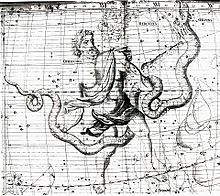 18th century star map illustrating how the feet of Ophiuchus cross the ecliptic
18th century star map illustrating how the feet of Ophiuchus cross the ecliptic
Zodiacal constellations
It is important to distinguish the zodiacal signs from the constellations associated with them, not only because of their drifting apart due to the precession of equinoxes but also because the physical constellations by nature of their varying shapes and forms take up varying widths of the ecliptic. Thus, Virgo takes up fully five times as much ecliptic longitude as Scorpius. The zodiacal signs, on the other hand, are an abstraction from the physical constellations designed to represent exactly one twelfth of the full circle each, or the longitude traversed by the Sun in about 30.4 days.[11]
There have always been a number of "parazodiacal" constellations that are also touched by the paths of the planets. The MUL.APIN lists Orion, Perseus, Auriga and Andromeda. Furthermore, there are a number of constellations mythologically associated with the zodiacal ones : Piscis Austrinus, The Southern Fish, is attached to Aquarius. In classical maps, it swallows the stream poured out of Aquarius' pitcher, but perhaps it formerly just swam in it. Aquila, The Eagle, was possibly associated with the zodiac by virtue of its main star, Altair.[citation needed] Hydra in the Early Bronze Age marked the celestial equator and was associated with Leo, which is shown standing on the serpent on the Dendera zodiac.[citation needed] Corvus is the Crow or Raven mysteriously perched on the tail of Hydra.
Due to the constellation boundaries being redefined in 1930 by the International Astronomical Union, the path of the ecliptic now officially passes through thirteen constellations: the twelve traditional 'zodiac constellations' plus Ophiuchus, the bottom part of which interjects between Scorpio and Sagittarius. Ophiuchus is an anciently recognised constellation, catalogued along with many others in Ptolemy's Almagest, but not historically referred to as a zodiac constellation.[12]
The technically inaccurate description of Ophiuchus as a sign of the zodiac dates to the 1970s.[citation needed] This drew prominent media attention on 20 January 1985, following the BBC's opening 'Nine o'clock News' announcement that "an extra sign of the zodiac has been announced by the Royal Astronomical Society".[13] Investigation into the source of the story revealed there had been no such announcement, and that the report had merely sensationalised the 67-year-old 'news' of the IAU's decision to alter the number of designated ecliptic constellations. This was done for the purposes of promoting a forthcoming BBC astronomy programme, presented by the RAS's Public Relation Officer, which touched upon the topic of precession.[14] The false assumption that Ophiuchus constitutes an astrological sign periodically resurfaces in the media, due to public misconception and failure to appreciate that the irregular astronomical demarcation of visible constellations does not relate to the separate frame of reference provided by the equally spaced twelve-fold longitude division of the ecliptic into zodiacal signs.[15]
Table of dates
The following table compares the Gregorian dates on which the Sun enters
- a sign in the Ptolemaic tropical zodiac
- a sign in the Hindu sidereal system
- the astronomical constellation of the same name as the sign, with constellation boundaries as defined in 1930 by the International Astronomical Union.
The theoretical beginning of Aries is the moment of vernal equinox, and all other dates shift accordingly. The precise Gregorian times and dates vary slightly from year to year as the Gregorian calendar shifts relative to the tropical year.[16] These variations remain within less than two days' difference in the recent past and the near-future, vernal equinox in UTC always falling either on 20 or 21 of March in the period of 1797 to 2043, falling on 19 March in 1796 the last time and in 2044 the next.[17] In the long term, if the Gregorian calendar is not reformed, the equinox will move to earlier dates: it will fall on 18 March for the first time in AD 4092.
Sign Constellation[18][19] Name Symbol Tropical zodiac
(2011)[20]Sidereal zodiac
(Jyotisha)
(2011, UTC)[21]Name IAU constellation
boundaries (2011)Solar stay Brightest star Aries 
21 March –
19 April14 April –
14 MayAries 19 April – 14 May 25.5 days Hamal Taurus 
20 April –
20 May14 May –
14 JuneTaurus 14 May – 21 June 38.2 days Aldebaran Gemini 
21 May –
20 June14 June –
14 JulyGemini 21 June – 21 July 29.3 days Pollux Cancer 
21 June –
21 July14 July –
14 AugustCancer 21 July – 11 August 21.1 days Al Tarf Leo 
22 July –
22 August14 August –
13 SeptemberLeo 11 August – 17 September 36.9 days Regulus Virgo 
23 August –
22 September13 September –
14 OctoberVirgo 17 September – 31 October 44.5 days Spica Libra 
23 September –
22 October14 October –
13 NovemberLibra 31 October – 21 November 21.1 days Zubeneschamali Scorpio 
23 October –
21 November13 November –
14 DecemberScorpius 21 November – 30 November 8.4 days Antares Ophiuchus 
n/a Ophiuchus 30 November – 18 December 18.4 days Rasalhague/ Alpha Ophiuchi Sagittarius 
22 November –
21 December14 December –
13 JanuarySagittarius 18 December – 21 January 33.6 days Kaus Australis Capricorn 
22 December –
20 January13 January –
12 FebruaryCapricornus 21 January – 17 February 27.4 days Deneb Algedi Aquarius 
21 January –
19 February12 February –
14 MarchAquarius 17 February – 12 March 23.9 days Sadalsuud Pisces 
20 February –
20 March14 March –
14 AprilPisces 12 March – 19 April 37.7 days Eta Piscium Because the Earth's axis is at an angle, some signs take longer to rise than others, and the farther away from the equator the observer is situated, the greater the difference. Thus, signs are spoken of as "long" or "short" ascension.[22]
Precession of the equinoxes
Further information: Precession of the equinoxes, Epoch (astronomy), Sidereal astrology, Tropical astrology, Astrological age, and AyanamsaThe zodiac system was developed in Babylonia, some 2,500 years ago, during the "Age of Aries". At the time, the precession of the equinoxes was unknown, and the system made no allowance for it. Contemporary use of the coordinate system is presented with the choice of interpreting the system either as sidereal, with the signs fixed to the stellar background, or as tropical, with the signs fixed to the point of vernal equinox.
Western astrology takes the tropical approach, whereas Hindu astrology takes the sidereal one. This results in the originally unified zodiacal coordinate system drifting apart gradually, with an angular velocity of about 1.4 degrees per century.
For the tropical zodiac used in Western astronomy and astrology, this means that the tropical sign of Aries currently lies somewhere within the constellation Pisces ("Age of Pisces").
The sidereal coordinate system takes into account the ayanamsa, a Sanskrit word where literally ayan means transit or movement and amsa means small part i.e. movement of equinoxes in small parts. It is unclear when Indians became aware of the precession of the equinoxes, but Bhaskar-ii in Siddhanta Shiromani gives equations for measurement of precession of equinoxes, and says his equations are based on some lost equations of Suryasiddhanta plus the equation of Munjaala.
It is not entirely clear how the Hellenistic astronomers responded to this phenomenon of precession once it had been discovered by Hipparchus around 130 BC. Today, some read Ptolemy as dropping the concept of a fixed celestial sphere and adopting what is referred to as a tropical coordinate system instead: in other words, one fixed to the Earth's seasonal cycle rather than the distant stars.
Some modern Western astrologers, such as Cyril Fagan, have advocated abandoning the tropical system in favour of a sidereal one.
In modern astronomy
Further information: Epoch (astronomy)The zodiac is a spherical celestial coordinate system. It designates the ecliptic as its fundamental plane and the position of the Sun at Vernal equinox as its prime meridian.
In astronomy, the zodiacal constellations are a convenient way of marking the ecliptic (the Sun's path across the sky) and the path of the moon and planets along the ecliptic. Modern astronomy still uses tropical coordinates for predicting the positions the Sun, Moon, and planets, except longitude in the ecliptic coordinate system is numbered from 0° to 360°, not 0° to 30° within each sign. Longitude within individual signs was still being used as late as 1740 by Jacques Cassini in his Tables astronomiques.
Zodiac is also used to refer to the zodiacal cloud of dust grains that move among the planets and the zodiacal light that originates from their scattering of sunlight.
Unlike the zodiac signs in astrology, which are all thirty degrees in length, the astronomical constellations vary widely in size. The boundaries of all the constellations in the sky were set by the International Astronomical Union (IAU) in 1930. This was, in essence, a mapping exercise to make the work of astronomers more efficient, and the boundaries of the constellations are not therefore in any meaningful sense an 'equivalent' to the zodiac signs. Along with the twelve original constellations, the boundaries of a thirteenth constellation, Ophiuchus (the serpent bearer), were set by astronomers within the bounds of the zodiac.
Mnemonics for the Zodiac
- The Ram, the Bull, the Heavenly Twins,
- And next the Crab, the Lion shines,
- The Virgin and the Scales.
- The Scorpion, Archer, and the Goat,
- The Man who holds the Watering-Pot,
- And Fish with glittering scales.
A less poetic, but succinct and perhaps more memorable, mnemonic is the following:[24]
- The Ramble Twins Crab Liverish;
- Scaly Scorpions Are Good Water Fish.
(Ram-Ble = Ram, Bull; Twins = Twins; Crab = Crab; Li-Ver(ish) = Lion, Virgin; Scaly = Scale; Scorpion = Scorpio; Are = Archer; Good = Goat; Water = Water Bearer; Fish = Fish)
Another easy mnemonic:
- All The Great Constellations Live Very Long Since Stars Can't Alter Physics.[25]
(Aries, Taurus, Gemini, Cancer, Leo, Virgo, Libra, Scorpio, Sagittarius, Capricorn, Aquarius, Pisces)
One more easy mnemonic:
- As The Great Cook Likes Very Little Salt, She Compensates Adding Pepper.
(Aries, Taurus, Gemini, Cancer, Leo, Virgo, Libra, Scorpio, Sagittarius, Capricorn, Aquarius, Pisces)
Remembering the translations/shapes of constellations with a fun mnemonic:
- Really Boring Teachers Can Live Very Sadly Since Apples Give Worthless Feelings.
(Ram, Bull, Twins, Crab, Lion, Virgin, Scales, Scorpion, Archer, Goat, Water Bearer, Fish)
- All That Gold Can Load Very Lazy Students Since Children Are at Play
(Aries, Taurus, Gemini, Cancer, Leo, Virgo, Libra, Scorpio, Sagittarius, Capricorn, Aquarius, Pisces)
See also
- Alexander A. Gurshtein
- Astronomical symbols
- Circle of stars
- Cusp (astrology)
- Elements of the zodiac
References
- ^ see MUL.APIN. See also Lankford, John History of Astronomy Routledge 1996 ISBN 978-0-8153-0322-0P.43, books.google.co.uk
- ^ OED, citing J. Harris, Lexicon Technicum (1704): "Zodiack of the Comets, Cassini hath observed a certain Tract [...] within whose Bounds [...] he hath found most Comets [...] to keep."
- ^ Powell 2004
- ^ Hugh Thurston, Early Astronomy, (New York: Springer-Verlag, 1994), p. 135–137.
- ^ E.W. Bullinger, The Witness of the Stars
- ^ D. James Kennedy, The Real Meaning of the Zodiac.
- ^ Ernest L. Martin, The Birth of Christ Recalculated (Pasadena, California: Foundation for Biblical Research, second ed., 1980), p. 167ff.[clarification needed]
- ^ D. Guthrie, J.A. Motyer (ed.), The New Bible Commentary (Grand Rapids: William B. Eerdmans Publishing Co., third ed., 1970) p. 173.
- ^ Derek and Julia Parker, Ibid, p16, 1990
- ^ MUL.APIN; Peter Whitfield, History of Astrology (2001); W. Muss-Arnolt, The Names of the Assyro-Babylonian Months and Their Regents, Journal of Biblical Literature (1892).
- ^ 30.4368 SI days or 2629743 seconds in tropical astrology and 30.4380 SI days or 2629846 seconds in sidereal astrology on average (the time spent by the Sun in each sign varies slightly due to the eccentricity of the Earth's orbit).
- ^ Ptolemy (2nd cent.). "VII.5". In R. Catesby Taliaferro. Almagest (1982 ed.). p. 239. Ptolemy refers to the constellation as Septentarius 'the serpent holder'.
- ^ Kollerstrom, N. (October 1995). "Ophiuchus and the media". The Observatory (KNUDSEN; OBS) 115: 261–262. Bibcode 1995Obs...115..261K. Reproduced online at SAO/NASA Astrophysics Data System (ADS), retrieved 13 July 2011.
- ^ Kollerstrom, N. (October 1995). "Ophiuchus and the media". The Observatory (KNUDSEN; OBS) 115: 261–262. Bibcode 1995Obs...115..261K.
- ^ The notion received further international media attention in January 2011, when it was reported that astronomer Parke Kunkle, a board-member of the Minnesota Planetarium Society, had suggested that Ophiuchus was the zodiac's '13th sign'. He later issued a statement to say he had not reported that the zodiac ought to include 13 signs instead of 12, but was only mentioning that there were 13 constellations; reported in Mad Astronomy: Why did your zodiac sign change? 13 January 2011.
- ^ The Gregorian calendar is built to satisfy the First Council of Nicaea, which placed vernal equinox is on 21 March, but it is not possible to keep it on a single day within a reasonable system of leap days.
- ^ See Jean Meeus, Astronomical Tables of the Sun, Moon, and Planets, 1983 published by Willmann-Bell, Inc., Richmond, Virginia. The date in other time zones may vary.
- ^ "Astronomical Almanac Online!(subscribers) U.S. Naval Observatory 2008". Asa.usno.navy.mil. http://asa.usno.navy.mil/SecC/Section_C.html. Retrieved 2010-06-02.
- ^ IAU concluded in 1977
- ^ "12 Zodiac Sign Profiles". http://my.horoscope.com/astrology/horoscope-sign-index.html. Retrieved 2011-01-16.
- ^ assuming an ayanamsa of 23.86° as of 2000 according to N. C. Lahiri. The precise value used may vary, but is usually set close to 24°.
- ^ Julia Parker "The Astrologer's Handbook", pp 10, Alva Press, NJ, 2010
- ^ Project Gutenberg ebook "An Alphabet Of Old Friends"; see Z for Zodiac.
- ^ Rey, H.A. (1952). The Stars, Houghton Mifflin.
- ^ Mnemonic: Zodiac Signs "Mnemonic: Zodiac Signs"
- B. L. van der Waerden, "History of the zodiac", Archiv für Orientforschung 16 (1953) 216–230.
- Emelianov, Vladimir. Nippurskij kalendar' i rannjaja istorija Zodiaka (Nippur Calendar and the Early History of Zodiac). St.-Petersburg, Peterburgskoje vostokovedenje, 1999.
- Ptolemy, Claudius (1998). The Almagest. Princeton, New Jersey: Princeton University Press. ISBN 0691002606 Translated and annotated by G. J. Toomer; with a foreword by Owen Gingerich.
- Powell, Robert, Influence of Babylonian Astronomy on the Subsequent Defining of the Zodiac (2004), PhD thesis, summarized by anonymous editor, Wayback version.
- Tropical v Sidereal debate, The Traditional Astrologer magazine, (Ascella), Issue 14, May 1997, pp. 23–27
- Peters, Christian Heinrich Friedrich and Edward Ball Knobel. Ptolemy's Catalogue of Stars: a revision of the Almagest. (1915). Publishers, Carnegie Institution of Washington.
External links
 Media related to Zodiac at Wikimedia Commons
Media related to Zodiac at Wikimedia CommonsThe Zodiac Astrology | Signs of the Zodiac Aries Taurus Gemini Cancer Leo Virgo Libra Scorpio Sagittarius Capricorn Aquarius Pisces 











Astronomy | Constellations of the Ecliptic Aries Taurus Gemini Cancer Leo Virgo Libra Scorpius Ophiuchus Sagittarius Capricornus Aquarius Pisces Greek astronomy Astronomers Acoreus · Aglaonike · Agrippa · Anaximander · Andronicus · Apollonius · Aratus · Aristarchus · Aristillus · Attalus · Autolycus · Bion · Callippus · Cleomedes · Cleostratus · Conon · Eratosthenes · Euctemon · Eudoxus · Geminus · Heraclides · Hicetas · Hipparchus · Hippocrates of Chios · Hypsicles · Menelaus · Meton · Oenopides · Philip of Opus · Philolaus · Posidonius · Ptolemy · Pytheas · Seleucus · Sosigenes of Alexandria · Sosigenes the Peripatetic · Strabo · Thales · Theodosius · Theon of Alexandria · Theon of Smyrna · Timocharis
Works Instruments Concepts Callippic cycle · Celestial spheres · Circle of latitude · Counter-Earth · Deferent and epicycle · Equant · Geocentrism · Heliocentrism · Hipparchic cycle · Metonic cycle · Octaeteris · Solstice · Spherical Earth · Sublunary sphere · Zodiac
Influences Influenced Western zodiac Elements Qualities Nature Categories:- Astrology
- Ancient astronomy
- Astrological signs
- Celestial coordinate system
- Constellations
- Early scientific cosmologies
- History of astrology
Wikimedia Foundation. 2010.


